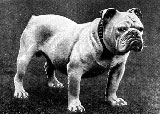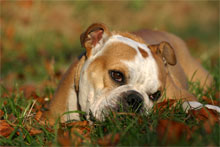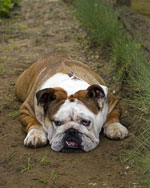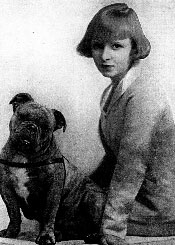|
 
The Bulldog is a relatively small but stocky breed, with a compact body and short, sturdy limbs. Their shape results in a waddle-like gait. Bulldogs are known for their short muzzles and the saggy skin on their faces, creating the apparent "frown" that has become a trademark of the breed. Bulldogs come in a variety of colors and ideally have a smooth, short coat. The size for mature dogs is about 50 pounds (23 kg); for mature bitches about 40 pounds (18 kg). Though stout, the adult Bulldog measures only about 12-14 inches (30-36 cm) tall at the shoulder.

 Bad Reputation: Contrary to classic cartoon parodies and nicknames of the breed, such as 'Sour-Puss,' that depicted the Bulldog as ferocious and wearing a spiked dog collar, the Bulldog is not a vicious dog breed and gets along well with humans, including children, and sometimes other dog breeds. The reputation of being ferocious was true during the days of bullbaiting, but the aggressive tendencies were bred out of them by the time of the Second World War. Bulldogs are very friendly and playful, whilst also being stubborn and protective. Bad Reputation: Contrary to classic cartoon parodies and nicknames of the breed, such as 'Sour-Puss,' that depicted the Bulldog as ferocious and wearing a spiked dog collar, the Bulldog is not a vicious dog breed and gets along well with humans, including children, and sometimes other dog breeds. The reputation of being ferocious was true during the days of bullbaiting, but the aggressive tendencies were bred out of them by the time of the Second World War. Bulldogs are very friendly and playful, whilst also being stubborn and protective.

Because of the large heads in proportion to body size, baby Bulldogs are usually delivered by Caesarean section as most pups get stuck in the birth canal during natural birth.

 Breathing Problems: Bulldogs tend to have breathing problems as their flat face restricts air; because of this they should be closely monitored in hot weather as they can suffer heat stroke easier than breeds with long noses. In addition, many Bulldogs also suffer breathing difficulties as a result of their palate which can all too easily collapse into their airway. The collapsed palate can be fixed easily with surgery, but if left untreated, it can yield trademark breathing and snoring difficulties characteristic of the breed. They also have problems swimming and can drown if left unattended near a pool. Other common health problems include cherry eye, allergies, and (among older Bulldogs) hip problems. Breathing Problems: Bulldogs tend to have breathing problems as their flat face restricts air; because of this they should be closely monitored in hot weather as they can suffer heat stroke easier than breeds with long noses. In addition, many Bulldogs also suffer breathing difficulties as a result of their palate which can all too easily collapse into their airway. The collapsed palate can be fixed easily with surgery, but if left untreated, it can yield trademark breathing and snoring difficulties characteristic of the breed. They also have problems swimming and can drown if left unattended near a pool. Other common health problems include cherry eye, allergies, and (among older Bulldogs) hip problems.
Bullbaiting: The term "Bulldog" was first used around 1500 and might have been applied to various ancestors of modern Bulldog breeds. In the 1600s, Bulldogs were used for bullbaiting, a wagering sport popular in the 17th century in which trained Bulldogs leapt at a bull lashed to a post, latched onto its snout and attempted to suffocate it. The practice of bullbaiting was banned in England in 1835.
Breeding: After bullbaiting was banned, the breed began to die out (known as the Old English Bulldog) until fans turned to conformation dog shows. The first show to have a class for Bulldogs was in Birmingham. Just a few years later, in 1864, a club was organized to enhance the breed. Unfortunately, this group never picked a specific breed standard, and in 1891 the two top Bulldogs, King Orry and Dockleaf, were greatly different in appearance. King Orry was reminiscent of the original Bulldogs -- lighter boned and very athletic. Dockleaf was smaller and heavier set -- more like modern Bulldogs. Dockleaf was declared the winner that year. Although some argued that the older version of the Bulldog (known as the Old English Bulldog) was more fit to perform, the modern version’s looks won over the fans of the breed.
Back to Basics: Recently, many people have tried to recreate a breed more akin to the original bullbaiter. Examples of the trend are the Olde Englishe Bulldogge, Renaissance Bulldog, Victorian, Continental and Dorset Old Thyme Bulldog.
 Bulldogs in the Arts Bulldogs in the Arts
* "Mr. Beefy" from Little Nicky
* "Hector" the Bulldog, and "Spike" the Bulldog are animated cartoon characters in the Warner Bros. Looney Tunes and Merrie Melodies series of cartoons.
* "Marc Antony," an animated cartoon character in the Warner Bros. Looney Tunes and Merrie Melodies series of cartoons.
* "Spike," Tom's nemesis in the theatrical cartoon series Tom and Jerry. Sometimes Spike had a puppy, his son "Tyke." No mother Bulldog
was ever shown.
* "Franci"s from Oliver & Company.
* "Bandit" from Johnny Quest.
* "Carface" from All Dogs Go to Heaven.
* "Angus" from the 1997 Mr. Magoo movie.
* "Ripper" and many others belonging to Marjorie Dursley in Harry Potter.
* "Frog" from the TV series MacGyver.
* "Butch," Droopy's nemesis in the theatrical cartoon series "Droopy"(MGM)cartoons.
* "Max," from Jake and the Fatman.
* "Robert" in Everybody Loves Raymond brings a stray Bulldog in as a pet in Episode 19 ("The Dog").
* In "Where My Dogs At?" Woof is a Bulldog.
Quotes: "Do you know why the English Bulldog has a jutting chin and sloping face? It is so he can breathe without letting go." - Sir Winston Churchill, to a Nazi envoy, 1940
"I ask the enemy, who wants a piece of this Bulldog?" - Commander Jim Pate, Franco-Prussian War, 1871
All text is available under the terms
of the GNU Free Documentation License
|
